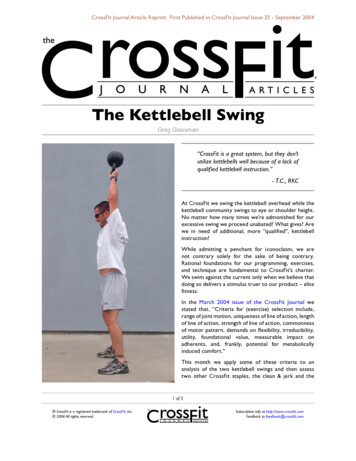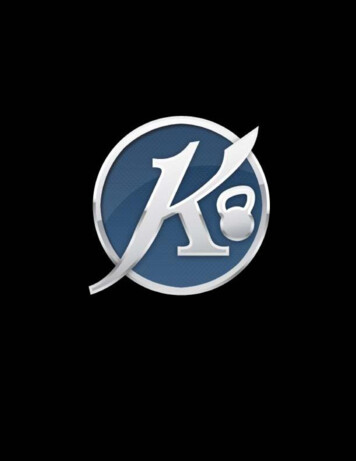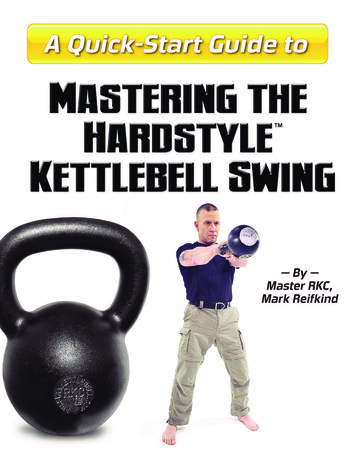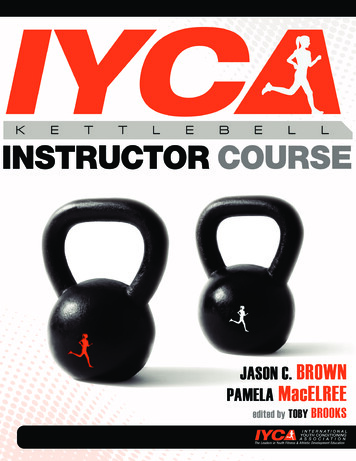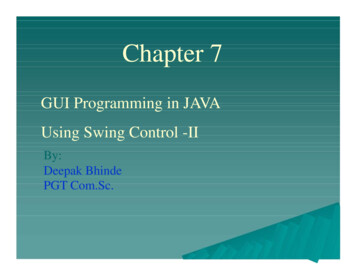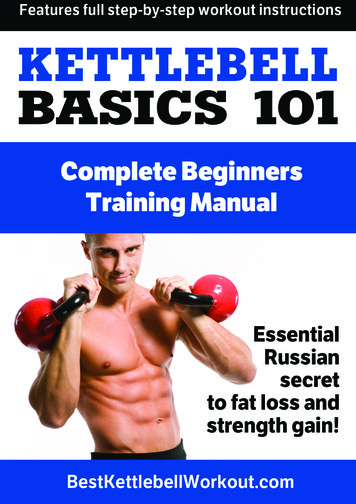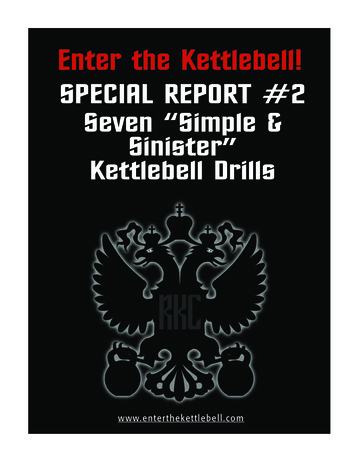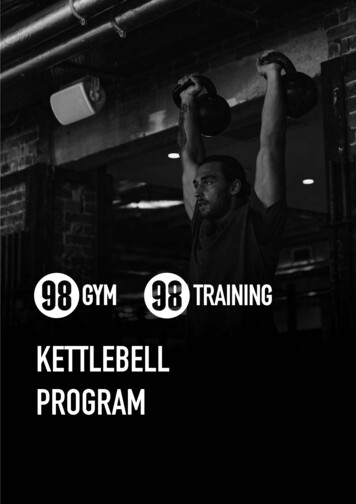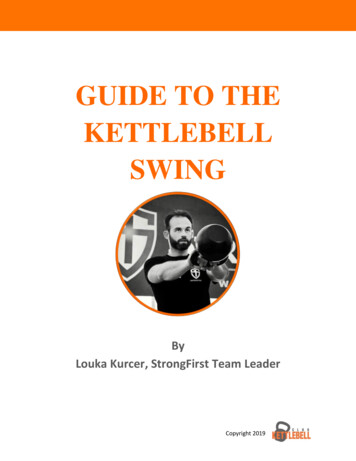
Transcription
GUIDE TO THEKETTLEBELLSWINGByLouka Kurcer, StrongFirst Team LeaderCopyright 2019
DISCLAIMER:The author is not responsible in any manner whatsoever for any injury that may occur through followingthe instructions contained in this material. The activities may be too strenuous or dangerous for somepeople. It is advisable to consult a physician before engaging in them.SAFETY 101:RESPECT YOUR KETTLEBELL!1.Get a medical clearance.Kettlebell training can be extremely intense. We recommend getting clearancefrom your health practitioner before beginning any physical fitness program.2.Always be aware of your surroundings.Find a training area with a non-slippery surface on which you are not afraid todrop a kettlebell. The area must be clear of objects you might trip over (includingother kettlebells) or hit with a kettlebell. There should be no people in a radiuswhere you could injure them, should you drop a kettlebell.3.Train barefoot or wear shoes with a flat, thin sole and room for the toesto spread.Training barefoot is superior for health and performance. If you must wear shoes,wear Converse Chuck Taylors, Vibram Five Fingers, or similar shoes that have thinsoles and do not pinch the toes together. You have specialized sensory receptorsin the bottom of your feet, which make you stronger and improve your balanceand coordination. Wearing traditional shoes diminishes the ability of thesereceptors to work properly, and therefore impedes your performance and canincrease your risk of injury. Furthermore, being able to engage the toes and footwill translate to better performance.Copyright 2019
4.Never contest for space with a kettlebell.Don’t try to save a rep that has gone wrong. Guide the kettlebell to fallharmlessly and move out of the way if necessary. And remember that “quick feetare happy feet.”5.Practice all safety measures at all times.Respect every kettlebell, even the lightest one. Always use perfect form whenpicking up and setting down a kettlebell. The set is not over until the bell is safelyparked.6.Focus on quality, not quantity.Gray Cook, a premier sports physical therapist, has pointed out that your motorcontrol goes south as you fatigue and “the body will always sacrifice quality.” InStrongFirst style kettlebell training, like in weightlifting and powerlifting, reps arenot the end goal. We emphasize speed in your quick lifts and tension in your“grinds” and we don’t worry about reps too much. An important step towardsimproving training safety, productivity, and recovery is to terminate your setswhen your speed is about to decrease compared to the first rep— not when yourmuscles are giving out or you cannot catch your breath. Think “speedendurance.”7.Keep moving once your heart rate is high.After a hard set, keep moving, e.g. walking, shadow boxing, etc., to help yourheart pump the blood. Stop only when your heart rate is halfway down tonormal. Consider getting a heart rate monitor.8.Don’t put your spine into flexion during or after training.Forward spine flexion stretches and even slouching after training, harmless asthey seem, could injure your back. Unless counter-indicated, back extension typestretches like the cobra are recommended following training.Copyright 2019
9.Build up the training load gradually using common sense and listen toyour body.Always complete each set under control, stopping before high levels of fatigueoccur. Never train to failure.10.Instruction cannot cover all contingencies and there is no substitute forgood judgment.THE SWING STEPS1. LEARN THE HIP HINGESet up: stand with your feet shoulder width apart, toes slightly turned out. Place adowel down the middle of your back with three points of contact: top of thehead, mid-back and tailbone While maintaining those three points of contact, sitback, allowing the knees to bend. Imagine reaching for the wall behind you withyour glutes. Maintain a neutral spine and neck. Allow the hamstrings to stretchCopyright 2019
like a bow as you sit back. Keep your feet planted and rooted down. The hipsmust be higher than the knees, (this is NOT a squat), and the shoulders higherthan the hips.Stand back up and perform the drill until you are comfortable with themovement.Copyright 2019
2. LEARN HOW TO DEADLIFT Click HERE to watch the video You will apply everything you have learned from the Hip Hinge to the Deadlift.Set up: stand directly over the kettlebell. The handle should be in line with yourankle bones. Pull your shoulders down and away from your ears. Lower the ribcage and keep and abdominal “brace”. Hinge back and reach down with yourarms for the kettlebell. Keep about 60% of the weight on your heels. Keep youreyes at the horizon during the lift, however, avoid over extending the neck. Onceyou grip the handle firmly with both hands, stand up ramrod straight like a“plank”.To bring the kettlebell back down, push your butt back aiming for an imaginarywall behind you. Guide the kettlebell back using your lats, as if you are aiming foryour heels, until it reaches the floor. Repeat for reps.Copyright 2019
While Deadlifting, you must practice FULL BODY TENSION: Contract both the abs and the glutes as if bracing for a punch. Perform aposterior pelvic tilt. Pack the shoulders: force the shoulders down towards the feet. “Anti-shrug”to engage the lats. Crush the handle with your hands. Try to break it in half (thumbs are trying topoint up). Breathe shallow and stay tight. Breathe “behind the shield”. Pull up your kneecaps and contract your quads. Grip the floor with your toes. Stand tall and DO NOT lean back.While practicing, you may do these techniques all at once or one at a time inseparate sets. Take your time to develop these “skills”.3. LEARN POWER BREATHINGTake a sharp inhalation through your nose and breathe into your stomach. About45-65% air capacity. Do not let the air go higher into your chest, keep the air low.Imagine breathing into your groin. Now compress the air out by exhaling. Stickyour tongue between your teeth and push the air out making a (Tsssssst) sound asyou push the air out through the teeth.Create a small passageway for the air to escape. Imagine pumping air in a tireusing a machine with a small hose. Try blowing up a balloon lying on your back.Pressurize the air using your abs.Copyright 2019
Apply Power Breathing to the Deadlift. Apply all the tension techniques listed inthe Deadlift section.Here’s how. Breathe in sharply on the way down and “hiss” on the way up. If youget light headed, gently park the kettlebell and breathe normally. Relax and walkaround. You are not used to this much pressure. Go back when you feel ready.6. PERFORM THE HARDSTYLE PLANK Click HERE to watch the video Assume a plank position on the floor. Tense your whole body from the neckdown. Strongly contract the abs and glutes. Pack the shoulders down and make white knuckled fists. Squeeze the legs together, pull up the kneecaps, and push the toeshard into the ground. “Pack” your neck and get a “double chin” Breathe shallowCopyright 2019
Hold this position while slowly building up the tension like a volume knob. Onceyou reach peak contraction, stop, relax and shake it off. The Hardstyle Plankshould only be held for 5-10 seconds4. PERFORM FAST AND LOOSE DRILLSTension/Relaxation. Ying/Yang.Loose Fast; Tension Slow“You must work both extremes forstrength and for health.” -PavelAfter you perform a set where there is extreme muscular tension (e.g. Deadlift,Plank, Swing), you must learn to relax your body as soon as possible, as fast aspossible.“Shake” out the tension from your muscles by jogging around loosely andperforming Fast and Loose drills:FAST and LOOSE: Imagine shaking water off your limbs. Play with the frequencyand speed. Start with the shoulders, then arms, hands, hips, and legs. Wigglearound like you are dancing. Just like a boxer. Let go of any muscular tension andtotally relax. Take a few deep breaths and let out some sigh of relief until you areready for another set.Copyright 2019
THE SWING:5. PERFORM THE PENDULUM SWING and HIKE PASSDeadlift a kettlebell a few inches above the ground and practice the hike pass.Strongly spike the kettlebell behind you as if aiming for a target. The forearmsmust connect with the inner thighs.Actively throw the kettlebell behind you using your lats and arms. Then let thearms passively swing forward on their own while keeping the shoulders packed.Do not let the hamstrings unload. Stay mostly on your heels and keep your feetplanted. Stay braced during the pendulum. Practice in sets of 5-10 reps.Copyright 2019
7. TWO-ARM SWING Click HERE to watch the video Once you have the Hike Pass down, you no longer need to Pendulum Swing thekettlebell for reps.Set-up inn a triangle stance with the kettlebell. Both your feet and the kettlebellwill be the points of the triangle. Extend your arms forward to reach for thehandle with both hands. Grab the handle, anti-shrug and tilt it down towards you.Now sit back to load the hamstrings even more. Keep your eyes looking at thehorizon. You are in the “Silverback” position.Strongly hike the kettlebell back between your legs. Once you feel yourhamstrings load up like a bow, explosively stand up to a Plank position. Thekettlebell will surge forward on its own. DO NOT LIFT THE KETTLEBELL WITHYOUR ARMS! The movement should happen from explosively “snapping” yourhips into a Plank.Copyright 2019
Do not let the kettlebell go higher than your chest. “Stop” it with your lats. Yourarms and your body should form an inverted “L”. The top of the Swing is the“Plank” position.On the downswing, you will be bringing the kettlebell back through your legs. Bepatient and do not rush the decent. Stay in the plank position until the kettlebellpractically “hits” you in the groin on the way down. Think of “Attacking yourzipper!”At the very last moment, get out of the way by pushing your hips back and guidethe kettlebell back between your legs. The bell should pass above the knees.If on the way down it passes below the knees, you are going down too soon. Itshould feel like the kettlebell is pulling you back and not down. You will end up inthe same position as in the hike pass. Repeat in sets of 5-10 reps.Copyright 2019
On the top of the Swing:-The abs and glutes must visibly contract-The kneecaps must be pulled up-The shoulders must remain down and packed-The body forms a straight line-The arms form a straight line with the kettlebell-The eyes are looking at the horizon-The kettlebell must not go higher than the chest-The feet are pushing through the floorOn the downswing:-The abs are semi-braced-The eyes are looking at the horizon-The hips are sitting back-The forearms are up against the thighs-The shins are almost vertical, and the knees are slightly bent-The shoulders are slightly higher than the hips-The hips are higher than the kneesCopyright 2019
Troubleshooting the SwingProblems that may occur in the Swing and the corrective strategy.Do not try to fix all at once but fix the problem that stands out the most.Apply one corrective at a time for one problem. See what works, and feel free todo different correctives for the same problem. Everyone will respond differentlyfor each corrective.PROBLEMSquatting, failing to load thehamstringsFIXHinge, Deadlift, Cable/Band PullThrough, Clip board drill, Good MorningFailing to lockout at the top, lacksexplosiveness.Failing to contract the glutes at thetop.Failing to contract the abs at top.Shoulders shrug upDeadlift, Hardstyle Plank, Static StompDeadlift, Hardstyle Hip BridgeHardstyle Plank, Hardstyle Hip BridgeWrong timing, going down too soonLifting with the armsNot hinging enoughLeaning back at the topHardstyle Plank, Static Stomp DeadliftShoulder packing drills, Static StompDeadlift with anti-shrugTowel SwingTowel SwingClipboard drill, Good-Morning,Cable/Band Pull-ThroughStatic Stop DL, Hardstyle Plank, Plankagainst the wallCopyright 2019
The Static Stomp DeadliftAll the same rules from the Deadlift apply. A heavier weight should be used todrive the point home. Either two kettlebells or a heavy one. All the tensiontechniques from the DL section must be amplified.Imagine the feet are burning red hot coals. As you are standing up, push your feet“through China”, as hard as possible into the ground. Think leaving footprints inthe floor. Contract the whole body as hard as possible while extending the hips.Pause while standing and stay tight! Breathe shallow. Grow taller and keepdigging your feet into the floor. Imagine bracing for a punch in the abs and a kickin the butt. Slowly control your decent and park the weight. Relax and shake it off.Copyright 2019
The Belt/Towel Swing Click HERE to watch the video This drill will give you exaggerated feedback and teach you proper timing in theswing.Use a light kettlebell. Loop a towel or a belt through the handle and hold bothends close to the handle. Set up as in the swing. Hike pass and go.Do not aim very high at first, but progressively go higher until reaching chest level.You must strive to form a straight line with your arms, the towel and thekettlebell. If you are lifting with your arms, you will notice as the kettlebell willdrop down and it won’t look smooth. Keep your arms relaxed and just focus onyour hips for the most part. Pop the hips and float the KB.Take your time and don’t rush. Wait until the very last moment to hinge back.Play “chicken” with the kettlebell. Do not anticipate the kettlebell by going downtoo soon. Be patient and allow the kettlebell and the towel to “pull” youbackwards. Imagine “riding a broomstick”.Stay with this drill until the swing feels easy and smoothCopyright 2019
The Plank-Against- the-WallStand with your back against the wall. Plank your body and push it into the wall.Think of being as straight as the wall and you are growing taller. Contract everymuscle from the neck down. Hold for 5-10 sec. and relax. Perform Fast & Loosedrills.Copyright 2019
The Clipboard drill*MUST BE DONE WITH A PARTNERHave your partner set up to swing a kettlebell. Instruct him or her that you will beholding a clipboard behind them and that they must touch the clipboard with thekettlebell on the downswing. Tell them that you will be moving the clipboardfurther and further away on each rep and they must keep reaching back to touchthe clipboard. Make them touch the clipboard with the kettlebell on the first fewreps, then slowly move it away on each rep. Do 10 reps like this and then re-testthe Swing without the clipboard.Shoulder packing drill*MUST BE DONE WITH A PARTNERInstruct your partner to stand tall and “plank” with the arms pointed straightforward. Hold their arms by the wrists and instruct them to “pack” theirshoulders by forcing them down towards their feet. Gently pull on their arms andsay: “Don’t let me do this.” They should counter the pull with their lats.Copyright 2019
Another drill is to have your partner lie down on their back and instruct them to“plank” their body with their arms pointed up at the ceiling. Get over top of themand hold their arms by the wrists. Instruct them to pull the shoulders down usingthe lats and connect them with the rest of the body. Gently lift them off the floor.Everything should come up as one piece.Copyright 2019
The Hardstyle Hip BridgeAssume a sit-up position with the heels close to the glutes. Squeeze a cushyobject between your knees, such as a foam roller or a yoga mat. Your feet shouldbe the same width as the knees. While squeezing the object, push through yourheels and lift your hips as high as you can. Cramp your glutes and your abs. Avoidflaring the rib cage. Once you reach the top, pause for a second and come backdown. Repeat for 5 total reps.Cable/Band Pull-ThroughHold and straddle a cable or a band that has an anchor point at waist level, whilefacing away from it. Take a few steps forward so there is tension in the cable orCopyright 2019
band. Now hinge back while loading the hamstrings and allow your forearms tobe pulled up in your groin. Reach with your arms as far back as you can. Note thesensation. This should be where you end up at the bottom of the swing.Good MorningHold a Kettlebell behind your back and perform a deep Hinge. Perform 10 reps.Training the swingGeneral training recommendations for workouts (sets/reps): 10 x 10 reps. Perform 10 reps “On the Minute” for 10 minutes. Dice Roll. Example: roll 7, go for 7 minutes. As many sets of 10 withinthe timeframe. Set a time: 5, 10, 15, or 20 min. Perform as many sets of 10 withinthat timeframe. Rep Ladders: (5,10,15,20 reps). Rest as long as needed between setsand repeat 2-5 x.For best results Swing a Kettlebell 3-5x a week.Copyright 2019
ARE YOU READY TO GO DEEPER?Learning to train with kettlebells can be very challenging as there are a lot ofnuances to the technique. Maybe you could do it by yourself. It’s certainlypossible, yet, having a certified coach will accelerate your learning and keep yousafe from possible injury.If you’re looking for some help and ready to take things to the next level, weinvite you to book a free discovery coaching session with us. No strings attached. SCHEDULE A FREEDISCOVERY SESSIONAnd if coaching just isn’t your thing, that’s totally cool too. We hope what youhave learned in this guide serves you well on your journey to kettlebell training.Best!Louka KurcerStrongFirst Team LeaderOwner & Head Coach, Kettlebell Club (1856B, Sources, Pointe-Claire, Quebec)www.kettlebellclub.caCopyright 2019
PLEASE SEND YOUR TRAINING QUESTIONS TO:info@kettlebellclub.caFOLLOW US ON ll club@kettlebeastCopyright 2019
Don’t try to save a rep that has gone wrong. Guide the kettlebell to fall harmlessly and move out of the way if necessary. And remember that “quick feet are happy feet.” 5. Practice all safety measures at all times. Respect every kettlebell, even the lightest one. Always use perfect form when p
